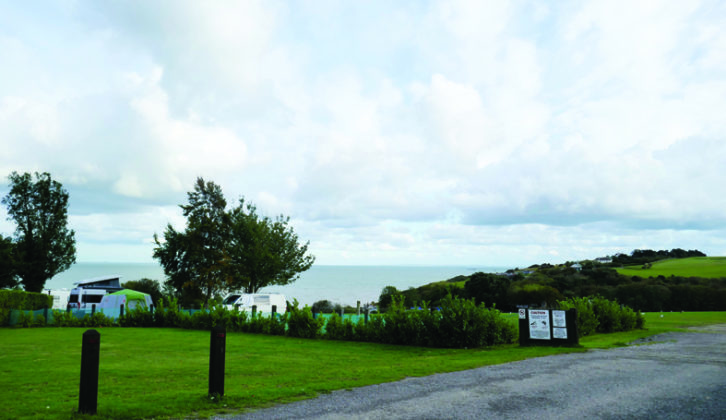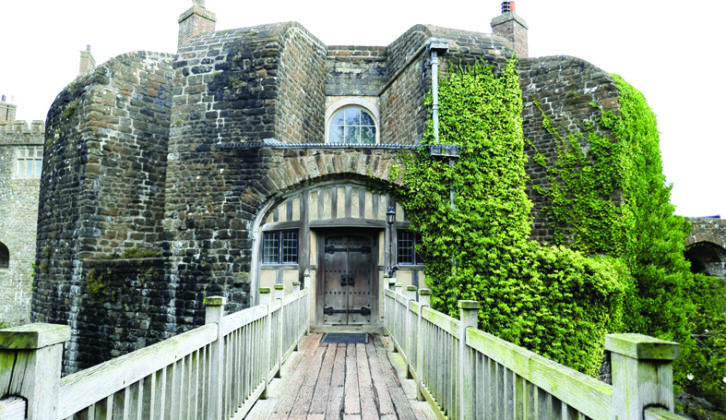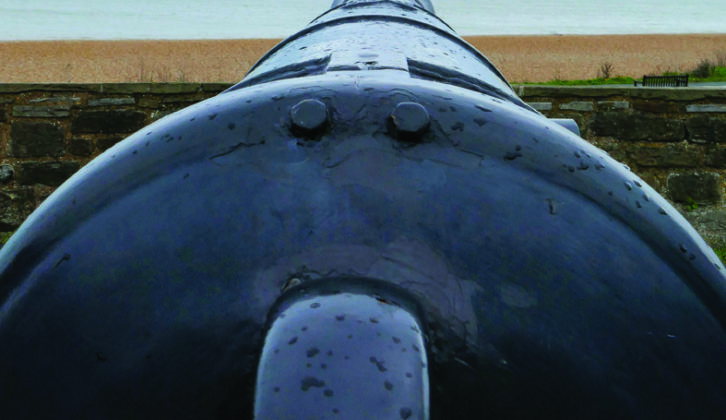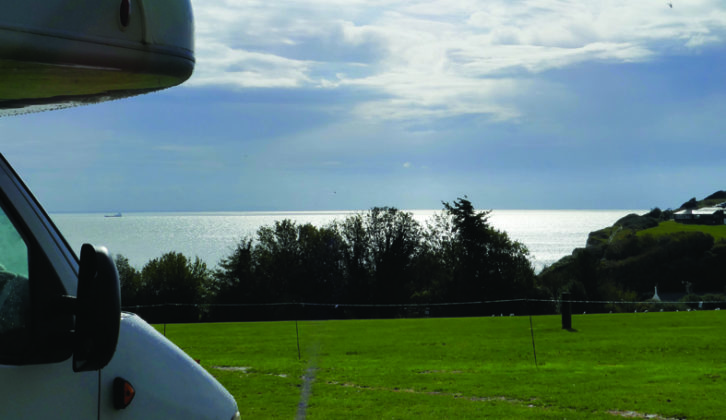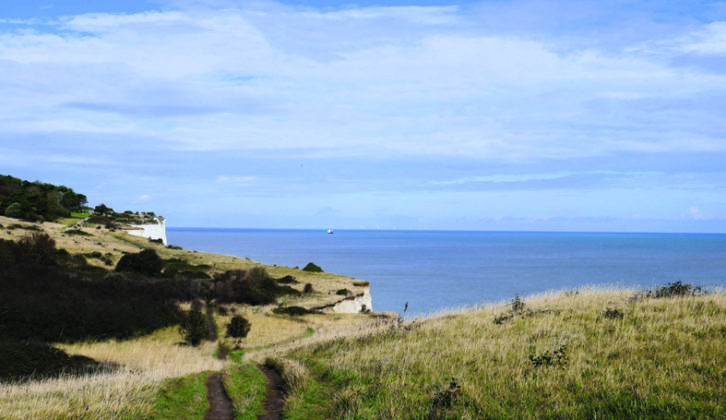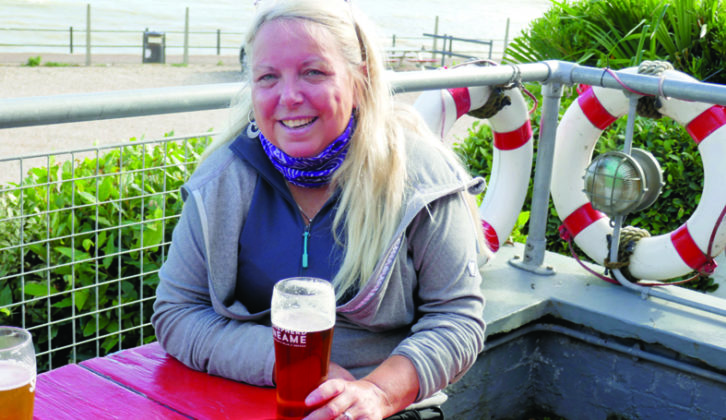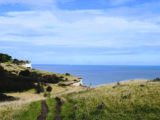Storm Alex was on her way, and we were booked to stay at Kingsdown International Camping Centre, roughly halfway between Dover and Deal, on the Kent coast.
After gazing back at those famous white cliffs from the deck during many a ferry crossing, I was looking forward to getting closer and walking on the clifftops, but the storm was threatening to put paid to my long-cherished plans.
However, I have never been one to let a little storm get in the way! Armed with hot chocolate, cold beers, cards and board games, my husband and I arrived at the campsite on a grey Saturday.
“Look at that amazing view!” I exclaimed, “You can see across the Channel to France.”
“Look at that mud!” groaned my husband, “I”m not sure we’ll get back out of this field.”
Views over the Channel

We were pitched in splendid isolation at the far end of the campsite, looking out over the English Channel and yes, we could just make out Calais 20-odd miles away.
Kingsdown provides a huge grassy field with electric pitches around the edge, so everyone has a sea view. There are also plenty of non-electric pitches, but no hardstanding. The site is ideally located, almost on the beach, and within walking distance of plenty of English history.
Unfortunately, we found that the gate leading to Kingsdown Beach was being kept locked, because of the site’s Covid-secure precautions, but it was still an easy 10-minute walk out of the site and along the footpath.
This is a fine beach for walking, but probably not the best for families who have very young children, because it is shingle and shelves quite steeply – although there are plenty of rock pools to explore at low tide.
It was a blustery afternoon as we took in the fresh sea air and close-up views of the white cliffs. Kingsdown lies on the Saxon Shore Way and the White Cliffs Country Trail – this is good, easy walking country.
Exploring Tudor heritage

Another reason we chose this location was to explore the Tudor castles at Walmer and Deal, both managed by English Heritage.
The close proximity of this coast to France has put it in the line of fire during many military conflicts throughout history, most notably during the reign of Henry VIII.
Henry was very conscious of the potential threat from across the Channel, as well as the suitability of this stretch of shingle coastline for landing an army. To shore up England’s defences, he commissioned three garrison forts, at Walmer, Deal and Sandown. Today, Sandown is little more than a ruin, after being part-demolished and incorporated into the sea defences in the 1970s. Both Walmer and Deal castles, however, remain standing, and are very worthy of a visit.
After an evening spent tucked up snugly in our motorhome, enjoying those cold beers and letting my husband win the odd game of Uno while we listened to the wind and rain battering the coast, I awoke the following morning ready to don buy boots and explore some castles.
It’s a 40-minute walk along the track following the coast from Kingsdown to Walmer Castle. Our first stop on arriving was for a crew tea in the castle café, to warm up and refuel before heading out to take a walk around the grounds, in the ever-present threat of rain.
Walking through history
Sadly, because of the virus, most of the castle’s interior was closed, but the grounds were open. Many historical figures have walked these paths before us, among them Tory politician William Pitt the Younger, who was largely responsible for fashioning the formal gardens and creating the sunken retreat, from a disused chalk pit, which later became known as The Glen.
This has been brought back to life in recent years and once again provides a habitat for a variety of flora and fauna.

The Duke of Wellington was another famous resident – he died at Walmer in 1852, in a room preserved to this day. This is in part thanks to William Henry Smith, of bookshop fame, who set up a trust to ensure the contents of the room remained unchanged, right down to the Duke’s Wellington boots. This intrigues me and I can’t wait for the interior to reopen one day, so I can see those boots for myself.
Having spent a very enjoyable couple of hours wandering around the lovely gardens, it was time to continue our coastal path walk, to Deal and our second castle of the day. By now, the sun had graced us with its presence and for the moment, all signs of Storm Alex had subsided.
Garrison life and times

In contrast to Walmer, Deal Castle was far less a residence and place of pleasure throughout its history, instead remaining a garrisoned castle.
No furnishings here, but a sense of how the garrison operated and the soldiers lived as they defended our coastline from all intrusions.
Deal Castle, according to the guide, was built as a series of ’rounded bastions’, designed to confuse enemy invaders. Despite the guide warning us to take care in the darkness when exploring one of these ’rounds’ (tunnels), I must admit I laughed when my husband dug a torch out of his backpack.
My laughter lasted all of two minutes into the darkness. There are no corners inside, and only slits in the external walls to let in a little daylight. The effect is very disorientating and it is nigh on impossible to keep a real sense of location as you walk around, bumping into walls that should not be in front of you! I have total respect for those long-ago soldiers defending our land in such conditions.
By the 17th century, most of the castle garrison had moved to live in the growing town of Deal, rather than the cold, storm-battered castle. It sustained heavy damage during the Civil War, and was taken and retaken by opposing sides, but remained armed and ready for war. The castle even saw action as a military fortification as recently as World War II – but is now in the safe hands of English Heritage.
From castles to cliffs

Deal itself is a friendly town, well worth an hour or so wandering, window shopping, and perhaps having a coffee or a bite to eat. We indulged in a quick pit in the chilly beer garden of one of the many pubs, before retreating to the warmth of our motorhome where a chicken curry awaited us for dinner.
The next day, all castled out, it was time for that long-awaited walk along the white cliffs. After a second night of storm winds and rain (thanks, Alex) we awoke to surprisingly blue skies and watery sunshine.
With breakfast despatched while enjoying that wonderful sea view, it was on with the walking gear and off to the cliffs. We climbed the steps from the beach to the Saxon Shore Way coastal path, heading in the direction of Dover, some six miles away. This is an easy trail to follow, and mostly flat once the steps have been managed. Provided you keep away from the edge, it should be suitable for anyone to enjoy.

Just before reaching our intended destination, St Margaret’s Bay, we paused at the Dover Patrol Monument, a memorial to a fleet of the Royal Navy which maintained navigation for Allied shipping across the English Channel during World War I and denied entry to the Straits of Dover to German submarines.
It was a moment to reflect on all of those acts of bravery and selflessness – this stretch of coast being just as attractive to would-be invaders in the 20th century as it was in the 16th. Indeed, the area was known as Hellfire Corner during World War II, because of the many intense air battles which took place overhead.
Close proximity to France
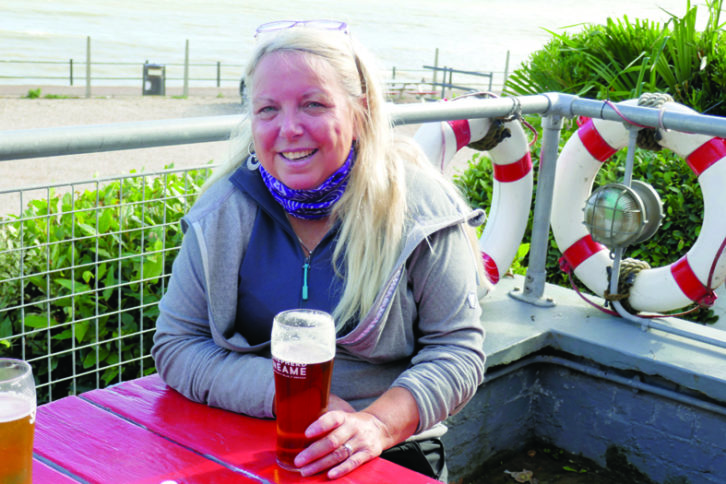
St Margaret’s itself is an interesting little town, and once home to Henry Royce, who designed the first Rolls-Royce aero-engine here in 1914. The walk down to the beach consists of so many steps I lost count and then, just as we thought we’d reached the bottom, we were faced with a steeply descending pathway to the shingle.
The reward, though, was a pint in the closest English pub to France! We were settled at a table outside The Coastguard, a pint of Spitfire in hand and a plate of sandwiches and chips on order, when my phone suddenly pinged.
“What’s this?” I wondered. “Why is my mobile phone provider contacting me?”
“Welcome to France! Whilst here…” was the message, Yes, my phone had got it into its head that we had actually caressed the Channel.
The confusion continued when we booked a taxi back to the site (fearing we would be late for a pre-booked dinner at a pub nearby), only to find our day had been moved on by an hour, the clock on my phone decided to join in and move us to French time!
Never mind: that meant we had plenty of time to relax before heading out to The Zetland Arms, a 10-minute stroll from the campsite, for dinner. Having passed the pub a few times on our walks, we couldn’t leave without a visit. Warm, cosy and with a lovely atmosphere, this pub on the beach below the cliffs was the perfect way to spend our final evening in White Cliffs Country.
TOUR ESSENTIALS
WHERE WE STAYED
Kingsdown International Camping Centre
- The Avenue, Kingsdown, Deal, CT14 8DU
- Web www.kingsdowncamping.co.uk
- Open 1 March – 31 October

The campsite is six miles from Dover, taking the M20, the A20, then the A258. As well as pitches it has indoor lodges for groups. They were not in use at the time of our visit, although the toilet block serving them was open, and very spacious.
Note that Kingsdown cannot accommodate larger motorhomes or caravans, because the roads into the campsite are unsuitable for such vehicles.
FIND OUT MORE
English Heritage annual joint membership costs £109 (up to two individual entry tickets are refunded if you join after visiting an attraction). Walmer Castle: Admission £12.60 adult, £7.60 child (family tickets also available). Deal Castle: Admission £7.90 adult, £4.70 child (family tickets also available). Visits must be booked in advance for both castles.
- The Zetland Arms: Wellington Parade, Kingsdown, Deal, Kent, CT14 9AF
- The Coastguard: The Bay, St Margaret’s Bay, Dover, CT15 6DY
If you liked this… READ THESE:
Top Sites – best motorhome and caravan parks in the UK 2021
If you’ve enjoyed reading this article, why not get the latest news, reviews and features delivered direct to your door or inbox every month. Take advantage of our brilliant Practical Motorhome magazine SUBSCRIBERS’ OFFER and SIGN UP TO OUR NEWSLETTER for regular weekly updates on all things motorhome related.
The reason we chose this location was to explore the Tudor castles at Walmer and Deal, both managed by English Heritage

